

Inquiry Charts (I-Charts) Grades 3 – 5 | Lesson Plan | Standard Lesson Critical Perspectives: Reading and Writing About Slavery Students critically explore the moral issue of slavery through reading fiction and nonfiction children's literature about the Underground Railroad, and they extend their understanding through creative writing projects.

Grades K – 2 | Lesson Plan | Unit. Teaching Students to Dig Deeper. Image credit: iStockphoto A backwoodsman went to a home improvement store and purchased a chainsaw to replace an old, worn-out saw.

After a month, the backwoodsman returned the saw to the store, complaining, "It doesn't work worth a darn! NY Collection of Tasks, Units & Student Work - Common Core Library. Keywords (optional) Enter keywords (e.g., K.OA.3, informational text, arguments, quadratic equations, etc.)

Grade (select at least one) Subject (select one) NYC educators and national experts are developing Common Core-aligned tasks embedded in a unit of study to support schools in implementing the Citywide Instructional Expectations. Educators may choose to adopt these resources in their entirety or adapt the materials to best address students’ diverse needs. Search a growing assortment of Common Core-aligned tasks, units and student work by keyword, grade level, subject area and Common Core Learning Standard. The components of the Common Core-aligned tasks with instructional supports include: Recommended Resources. Www.stenhouse.com/fiae (For study guides for Fair Isn’t Always Equal, videos, responses to questions, articles, teacher testimonials, and much more) www.debbiesilver.com Differentiation Central (Carol Ann Tomlinson’s wonderful Website on Differentiation) Research that Supports Differentiated Instruction (From Differentiation Central) Putting Points and Percentages into the Past (Wonderful Prezi presentation on standards-based grading) Transforming Assessment (Great Website on assessment from the Education Ministry of British Columbia, Canada) www.edunators.com (by Mark Clements — Powerful Website focused on teaching, assessment/grading, professional connection, technology, risk-taking)
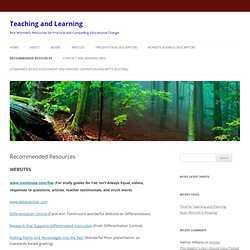
Webb’S Depth Of Knowledge. The Knowledge Gear. Twenty-first century science offers a new way of looking at and understanding the workings of the human brain.
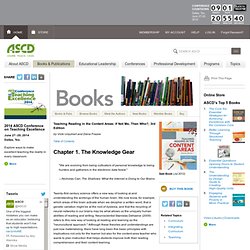
We now know, for example, which areas of the brain activate when we decipher a written word, that a genetic variation might be at the root of dyslexia, and that the recycling of neural networks in our brains may be what allows us the uniquely human abilities of reading and writing. Neuroscientist Stanislas Dehaene (2009) refers to this new way of looking at reading and learning as the "neurocultural approach. " Although these theories and understandings are just now materializing, there have long been five basic principles with implications not only for the learner but also for the content-area teacher who wants to plan instruction that helps students improve both their reading comprehension and their content learning. Revisiting the Five Basic Premises of Teaching Reading. Common Core Standards Make a Mockery of Novels' Complexity. Here’s a pop quiz: according to the measurements used in the new Common Core Standards, which of these books would be complex enough for a ninth grader?
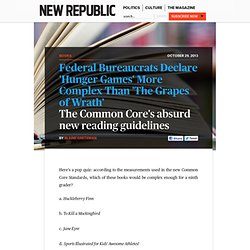
A. Huckleberry Finn b. THE Key Ingredient to a Successful Reading or Writing Lesson. LehmanRoberts_FallingInLoveWithCloseReading_infographic.jpg (JPEG Image, 1800x1800 pixels) - Scaled (35%) The%20Exchange%20Newsletter,%20October%202013. A Day in the Life of a Close Reader. We are almost at the end of our 7-week blog-a-thon on #closereading!

We invite YOU to join in! Find more on how-to here. Several selected posts have already been linked to on the Contributors page and we are looking forward to your addition. Let’s closely read the practice of close reading together! It’s time to retire E D Hirsch’s tired refrains. The time-consuming test prep with endless exercises on “finding the main idea” and “questioning the author,” exercises that are supposed to help improve verbal abilities, have become the chief cause of today’s curriculum narrowing.
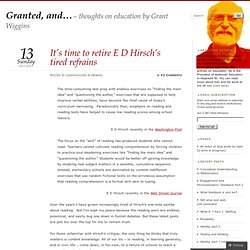
Paradoxically then, emphasis on reading and reading tests have helped to cause low reading scores among school leavers. E D Hirsch recently in the Washington Post The focus on the “skill” of reading has produced students who cannot read. Teachers cannot cultivate reading comprehension by forcing children to practice soul-deadening exercises like “finding the main idea” and “questioning the author.”
Blog-a-thon Post 9: Complex Texts or Complex Kids: Which Texts Are “Worth” #CloseReading. Welcome to the fifth week of our 7-week blog-a-thon on #closereading.
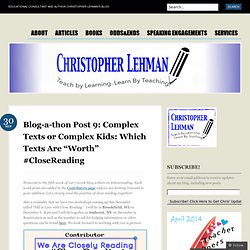
Each week posts are added to the Contributors page and we are looking forward to your addition. Let’s closely read the practice of close reading together! Also a reminder that we have two workshops coming up this December called “Fall in Love with Close Reading.” Close Reading & Scientific Text: Patterns of Comparison. Too often, images like this one are used in scientific text as decoration on the page with little explanation about their relationship to text.

If this is a pattern you see in your textbook, draw attention to it, not away from it. Have students explain and analyze the image in relation to the print text. Hover or click on the image to read more about it. (Image from Wikimedia Commons) From Inspiration to Red Carpet: Elementary Book Trailer Project. In honor of the Oscars, here is the first of two excerpts from From Inspiration to Red Carpet: Host Your Own Student Film Festival by William L. Bass, Christian Goodrich and Kim Lindskog. The project below is for a video book trailer. Video trailer for student film festival - Credit: William Bass Video book trailers are short, less than two-minute videos that introduce a basic storyline, utilizing images, sound and voice, designed for a particular audience. A Lesson in Close Reading: The Sonnet and CCSS RL.7.5. Click the link to join our conversation on close reading.
Do the Math: Three Reasons Biography and Autobiography Should Be Minimized in Your Informational Text Instruction (Part 1) Educational Leaders, Arts Standards, and the Common Core: Lessons from Recent Research. Nancy Rubino Amy Charleroy In a recent survey conducted by the College Board of nearly 1000 K-12 principals and superintendents, more than 75% of respondents said that nationally, arts education should be given a greater priority level than it currently holds in American schools. They also indicated that they believe that the primary benefits of arts education are that they strengthen students’ creative thinking abilities, bolster cognitive development, contribute to a well-rounded educational experience and enhance students’ emotional well-being. However, when asked what factors could most effectively work in favor of keeping arts programs in schools, school leaders responded the arts curricula need to clearly address state educational standards (in the arts as well as in other subjects), college admission requirements, and the Common Core standards.
Articles of the Week (AoW) Please note that, as I explain in-depth in this blog post, I take no credit for coming up with the article of the week (AoW) assignment. Kelly Gallagher (or, as I sometimes call him, The Gallagher) is the man who first introduced me to the idea through his must-read book Readicide. Thus, anything I share about my classroom’s experiences with AoWs, any theories or experiments I try out with the assignment, and any success my students or I have with it thoroughly and ultimately traces back to Kelly’s work. If I ever come across as the progenitor of this idea, please either drive to Michigan and egg my house OR contact me here so I can fix attribution mistakes.
How To Use Informational Text In Your Classroom. Whether you are reading this at the beginning or end of your work day, take a moment and do a mental "reading list" inventory. What works of fiction are you currently reading? During the day, how many news articles, websites, journal articles, non-fiction books, emails, documents, directions, graphs, charts, maps and diagrams will you be looking at to gather information? What kind of writing and talking will you do? Will any of it require you to go back into the "informational text" materials to find information to support what you are writing or talking about? I suspect that many of you spend a great deal of your professional and personal time focusing more on the "informational" side of text then the "literary" side of text - maybe by choice, maybe by necessity.
A Research-Based Instructional Practice. The EdCafe model is founded in research-based practices. Below, you’ll find notes taken from various research studies, book chapters, and literature on peer discussion, collaborative learning, and intentional classroom scaffolding. Comprehension: High-Level Talk and Writing about Texts. The Knowledge Gear. Teaching with Primary Sources Program- Teaching with Primary Sources. About the Program The Teaching with Primary Sources Program works with colleges and other educational organizations to deliver professional development programs that help teachers use the Library of Congress's rich reservoir of digitized primary source materials to design challenging, high-quality instruction.
Close Reading and Writing in Science and Technical Subjects. Tools for Creating Creating Screen Capture Images and Videos. This evening I received a question from a reader who was wondering what I use to create the annotated screen capture images that you see in the guides that I produce. Educurious-Draft-LDC-Science-Templates-June15. Five close reading strategies to support the Common Core. I walked in to my first college class, Political Science 101, eager to learn. Literacies ELA, SS/H, Sci, Tech. CCSS Resource: Guiding Questions for Close Reading. Critical Thinking Model 1. To Analyze Thinking We Must Identify and Question its Elemental Structures. We Are Closely Reading #CloseReading: Blog-a-thon Contributors Page.
Connections: Investigating Reality - A Course of Study. A comprehensive general education course of study for adolescents and older learners • Explains learning to learners • Relates all school subjects simply and logically • Integrates the arts and sciences • Makes routine use of all thought processes • Stimulates creativity and ingenuity through active learning • Challenges all ability levels equally • Capitalizes on individual differences • Is consistently, unquestionably relevant • Does not “privilege” the dominant culture • Maximizes dialog and cooperative learning • Adapts to traditional bureaucratic demands • Makes provision for inter-school communication and continuous course improvement • Replaces school subjects as information organizers with a single, much simpler, more natural organizer • Moves learners steadily through ever-increasing levels of conceptual complexity • Returns curricular control to those best positioned to improve it—classroom teachers • Builds in criteria establishing the relative importance of information.
Blog-a-thon Post 1: What #CloseReading Isn’t (Or At Least Shouldn’t Be)
Literary Analysis Using Evidence And Analysis For Students. Blog-a-thon Post 1: What #CloseReading Isn’t (Or At Least Shouldn’t Be) Close Reading Resources. OER Review: Report - Digital Learning Department @ OSPI. Evernote, NoteShelf, GoodNotes..3rd grade teacher. Today's guest blog is written by third grade teacher Melissa Weatherwax. Melissa teaches at Poestenkill Elementary School in the Averill Park Central School District and she flawlessly uses technology in her inquiry-based classroom. Notability and Notetaking.